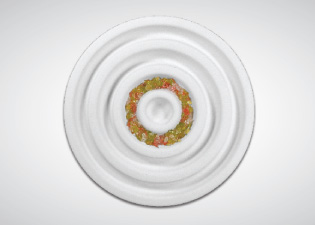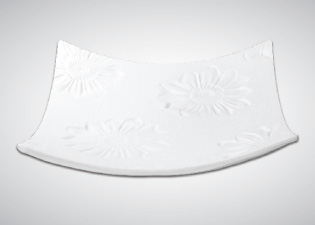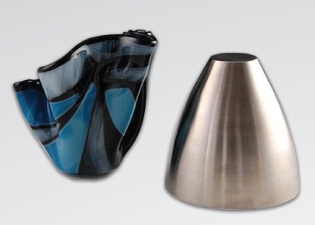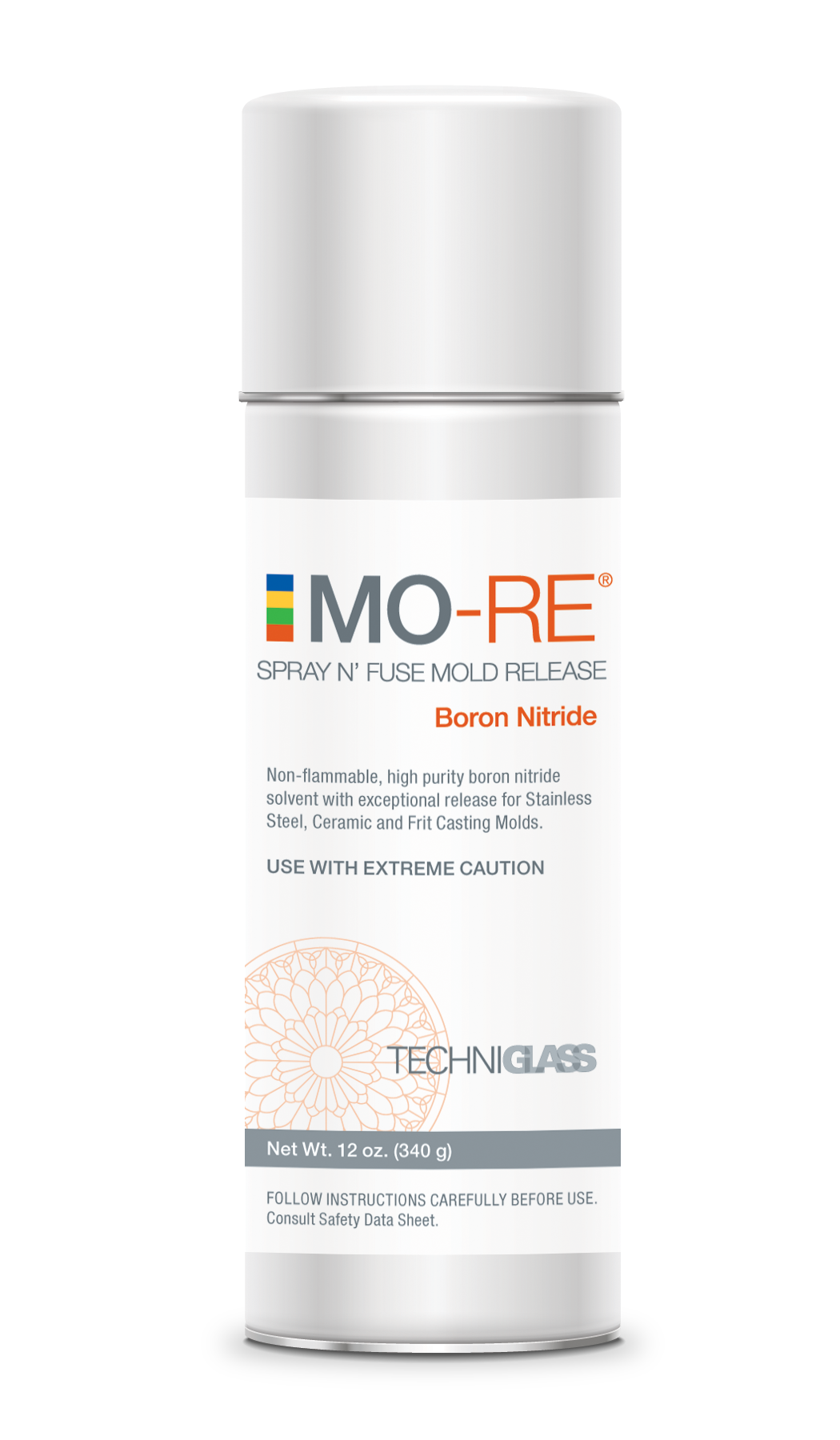Here’s What Artists Are Saying…
What a difference! I’ve gotta say, I am a dedicated fan of this company. Have just started working with your new MO-RE® boron nitride spray. My results have produced clean lift off of my glass from my damming molds, which is of course the point of the product, but I must say, my favorite thing about this spray over others I have used is it doesn’t stink up my studio! I am all, about the complete user experience.
FEATURES
The premier boron nitride mold release made especially for the fusing glass enthusiast and professional.
Each masterpiece can be easily removed from any mold cleanly without any post-fire work needed.
Radically Different
Glass is the most difficult application to release, that’s why Techniglass has formulated MO-RE specifically for the art glass industry. With a non-flammable solvent base, MO-RE produces an effortless release for a wide array of molds.
Reduce Prep Time
Application and cleanup are simple compared to brush-on primers; MO-RE sprays on quick and evenly with self-leveling capabilities. No exposed mold or mold sticking to glass piece.
Flawless Release
Eliminate post-fire work with MO-RE’s unique composition, allowing glass to move freely during the firing process. When boron nitride release spray is applied evenly, each mold will release clean with no spiked edges or film left on glass. No need to grind off rough edges!
Reduce Cost per Application
MO-RE can be used sparingly, due to its self-leveling component one will never need to worry of an uneven surface or bare mold. Only a light coating is necessary – by reducing the amount applied to each mold, less mold release is used during the application process.
Efficient and Self-Leveling
MO-RE Spray n’ Fuse Mold Release consists of microscopic solvent particulates that are expelled onto a surface by a liquid propellant. The unique formulation appears wet upon application, undergoing a self-leveling process to create an ideal barrier between glass and mold.



INSTRUCTIONS & USE
Please Follow Instructions Carefully
1.
Shake can vigorously for 1 min. before use to ensure proper suspension of contents
2.
Hold can at 45° angle during application

3.
Distance the can 10 to 14 inches (26–36cm) from object
4.
Spray in a swift, sweeping motion beginning off surface of object, continuing off other side
5.
On needed basis, rotate small objects
6.
Allow full 5-10 min. drying time
7.
Apply a light second coating once first coat has completely dried
- This is a self-leveling product; initial application will appear wet.
- If glass is difficult to release, a full drying time was not applied.
- If you find the product is leaving ‘scum on glass’ – too much product has been applied.
TYPE & SIZE
| Item No. | Description | Quantity | Volume | Dimensions | Weight | ||
|---|---|---|---|---|---|---|---|
| English (in) | Metric (cm) | English (lbs) | Metric (g) | ||||
| MO-120 | 12 oz. Can | 1 | 276 ml | 9×3 | 23×8 | 0.78 | 340 |
| 12 oz. Case | 12 | 3.3 L | 12x9x9 | 31x23x23 | 10 | 4536 | |
Frequently Asked Questions
DISTANCE - How far away from the mold should I spray?
Approximately 10-14 inches (26-36cm) from object with MO-RE mold release spray
SHAKING - How long do I need to shake the can before applying it?
Shake the can of MO-RE for at least one minute after hearing the mixing balls move. We recommend spraying a quick test spritz onto a scrap of cardboard or colored paper to ensure that the boron nitride is sufficiently mixed with the solvent. If the test spray is white, proceed with application process. If it is clear, shake the can until the spray stream is white.
NUMBER OF COATS - How many coats should I apply?
A first coating should be applied and allowed to dry for 5-10 minutes followed by a second light coating. Refer to instructional video for details.
SPRAYING - What method should I use to spray Boron Nitride?
Spray in a swift, sweeping motion beginning off of the surface of the object, continuing off the other side. Again, spray 10-14 inches (26-36cm) from object. Refer to instructional video for details .
DRYING - For how long should I let each application dry?
Allow for a 5-10 minute drying time depending on thickness of coat.
TEMPERATURE - What temperatures can MO-RE withstand?
MO-RE mold release spray is specially formulated as a non-flammable safe solvent that can withstand a firing process of 500F/260C up to 1600F/872C.
LAYERING - Can I layer another formula of Boron Nitride along with MO-RE?
We have successfully layered MO-RE over ZYP as well as ZYP over MO-RE in our product testing.
COATING – CERAMIC MOLDS - Is the coating of MO-RE permanent or temporary?
Ceramic Mold: Once MO-RE mold spray has been applied to a ceramic mold, it will no longer be porous enough to accept kiln wash coating. MO-RE can be cleaned from a ceramic mold before applying another boron nitride product.
COATING- STAINLESS STEEL MOLDS - Is the coating of MO-RE permanent or temporary?
Stainless Steel: Once MO-RE mold spray has been applied to a stainless steel mold, MO-RE can be brushed off of the Stainless mold.
TYPE OF MOLDS - Can MO-RE be used on any type of mold?
MO-RE is an effective glass separator on ceramic, stainless steel, and frit casting molds.
COLOR - Is MO-RE clear or does it have color to it?
The boron nitride is white, the solvent is clear. We recommend spraying a quick test spritz onto a scrap of cardboard or colored paper to ensure that the boron nitride is sufficiently mixed with the solvent. If the test spray is white, proceed with application process. If it is clear, shake the can until the spray stream is white.
REMOVAL – CERAMIC MOLDS - How do I remove MO-RE from a mold?
Ceramic molds can be cleaned between uses for additional boron nitride application, but it is not recommended to use kiln wash on a ceramic mold that has been previously coated with MO-RE.
KILN WASH - Can I use MO-RE on a mold that has previously been kiln washed?
Yes, be sure to clean to mold thoroughly then apply the MO-RE mold release spray to the mold.
FRIT CASTING - What firing schedules do you recommend for frit casting?
We recommend a lower schedule for frit casting. Over-firing frit casting molds can cause the glass to distort.
FREQUENCY OF APPLICATION- CERAMIC MOLDS How often should I reapply MO-RE to my molds?
Ceramic molds used for slumping usually do not need recoating between uses.
SLUMPING – STAINLESS STEEL MOLDS Can I use MO-RE instead of kiln wash on slumping molds?
MO-RE release spray is ideal for all stainless steel molds. It is highly recommended to use MO-RE instead of kiln wash as kiln wash is extremely difficult to remove from the mold.
FREQUENCY OF APPLICATION- FRIT CASTING MOLDS How often should I reapply MO-RE to my molds?
Molds going to full fuse temperatures (frit casting), should be cleaned and recoated each time they are used.
CLEANING CERAMIC MOLDS - How do I clean my molds?
To clean: using a stiff nylon brush, sweep out all loose powder and vacuum residue. Surface of the mold may appear shiny. One application of MO-RE is sufficient for re-use. The surface of the mold should appear matte after spraying.


